We’re going into the world of image transfer onto wood, and we’re going in deep, So grab your scuba gear.
Whether you want to transfer a photo print to wood, or you have a cool graphic image/words you need to transfer, there are several highly satisfying ways to do this. Seriously, it’s so fun to peel back that piece of paper and see your image beautifully transferred over to whatever wood you’re using.
I experimented with image transfer on wood using wax paper, freezer paper, gesso, t-shirt iron on paper, paint, Acetone, blender pen, and acrylic gel medium. Here are my extremely non-scientific results.
Table of Contents: Click on a link to be transported directly to that section.
- Wax Paper and Freezer Paper Wood Transfer
- T-shirt Transfer Paper on Wood
- Mod Podge and Acrylic Gel Medium Transfer to Wood
- Blender Marker Transfer to Wood
- Acetone Transfer to Wood
- Citrasolv Print Transfer to Wood
- Image Transfer to Painted Wood
Important Reminders:
Print a mirror image out of your photo (especially if you’re printing words or a face) so it isn’t backwards once you transfer it.
Your wood surface needs to be as smooth as you can make it for the most successful print results. Fine grit sandpaper is your friend here.
When cutting your images out of the paper, leave a little white border around them to give your fingers a place to hold the paper down, and also so you don’t have to worry about cutting the edge of the image perfectly straight.
If you’re transferring right to the wood, as with the wax and freezer paper and blender marker methods, you can use more force with the burnisher. When you’re using the gel medium/gesso/paint techniques, just press down hard enough to flatten the image into the goop and get as many air bubbles out of the paper as you can.
Inkjet Print Transfer With Wax Paper and Freezer Paper
You can use wax paper and freezer paper to transfer your prints onto wood, and I did some experimenting to see which worked better.
The reason this works is that the waxy finish on these papers keeps the ink from soaking into the paper, so it transfers over to your wood easily. You can feed the papers right through your inkjet printer, but there are a few little tips to follow.
Supplies:
- Inkjet printer
- Wax paper
- Freezer paper
- Credit card or plastic scraper – something like that to burnish the prints
- Wood surfaces: painting panels, cut wood pieces, anything smooth and unfinished
- Clear spray fixative if you want to seal your print
Here are my printing results with wax paper vs. Freezer paper:
Print Transfer With Wax Paper
I cut several pieces of wax paper simultaneously: you tape a piece of letter-sized printer paper over a long piece of wax paper folded over on itself a few times. Use a big metal ruler (these are indispensable for so many projects) and a craft knife to cut around the printer paper.
I put a piece of wax paper in my printer tray and printed straight on that. I only had the occasional paper jam. 🙂
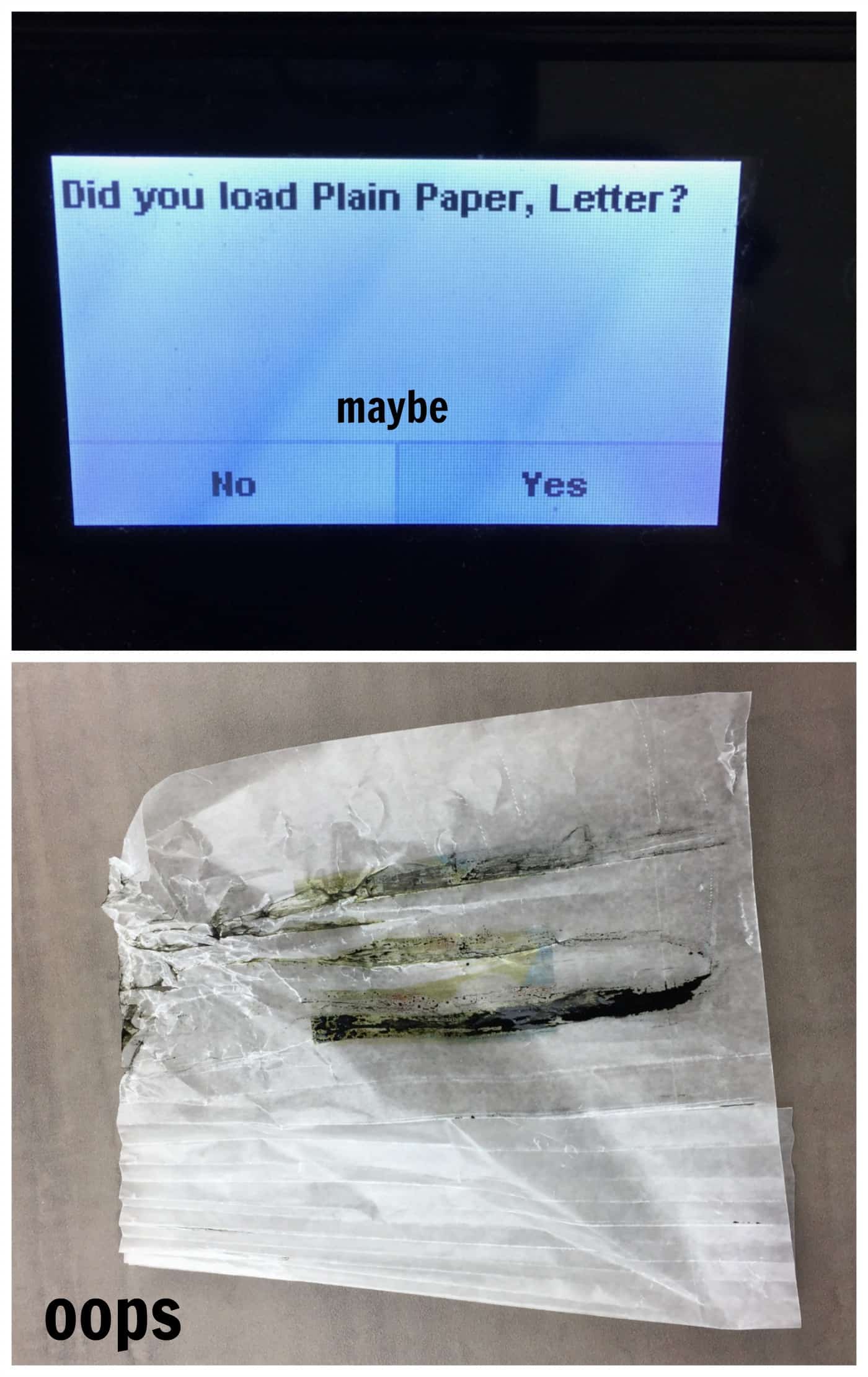
Remove the print from the printer carefully, without touching the ink! It will smudge so easily since it’s mostly sitting on the surface of the wax.
Print Transfer With Freezer Paper
When printing on freezer paper, I found that even though it’s thicker than wax paper, I needed to tape it to a piece of printer paper before loading it into the paper tray. Otherwise, it was jam-city.
Use double-stick tape and attach the freezer paper to the printer paper shiny side out. After it prints, be super careful to not touch the ink, and you can cut around your print with scissors or gently detach the printer paper from the freezer paper. Be patient so you don’t smudge the ink! The paper likes to curl back on itself and be a general nuisance.
Transferring the Image From Wax Paper or Freezer Paper
The process is the same at this point for both wax and freezer paper. Flip your image over slooooowly, carefully onto the wood surface. It helps to hold your breath and sweat a lot while you’re doing this.
Once you have your image positioned where you want it on the wood, hold it in place firmly (or tape it), and use the edge of a plastic scraper or credit card to burnish the image onto the wood.
Here’s where experimentation before making the finished piece really comes in handy. The image will want to slide around on the wood surface due to its waxy coating and all, so you need to hold that thing down. You’ll be able to see through the paper (more easily through the wax paper). If your image looks like it has shifted, reposition it as best you can.
Overly-aggressive burnishing can cause the paper to rip, so you will want to find a balance between burnishing like you mean it and anger burnishing.
Peel your paper back in areas while holding the rest of it in place to see if your image looks good.
I found that the freezer paper images tended to look a little more saturated and complete on the wood than the wax paper, so I prefer the freezer paper. But! Think about the end result you are going for: maybe you want more of a weathered or vintage look to your print transfer, in which case you might prefer wax paper.

This one I tried with color prints of areas from Hieronymus Bosch’s The Garden of Earthly Delights. The surface is a big piece of birch plywood.

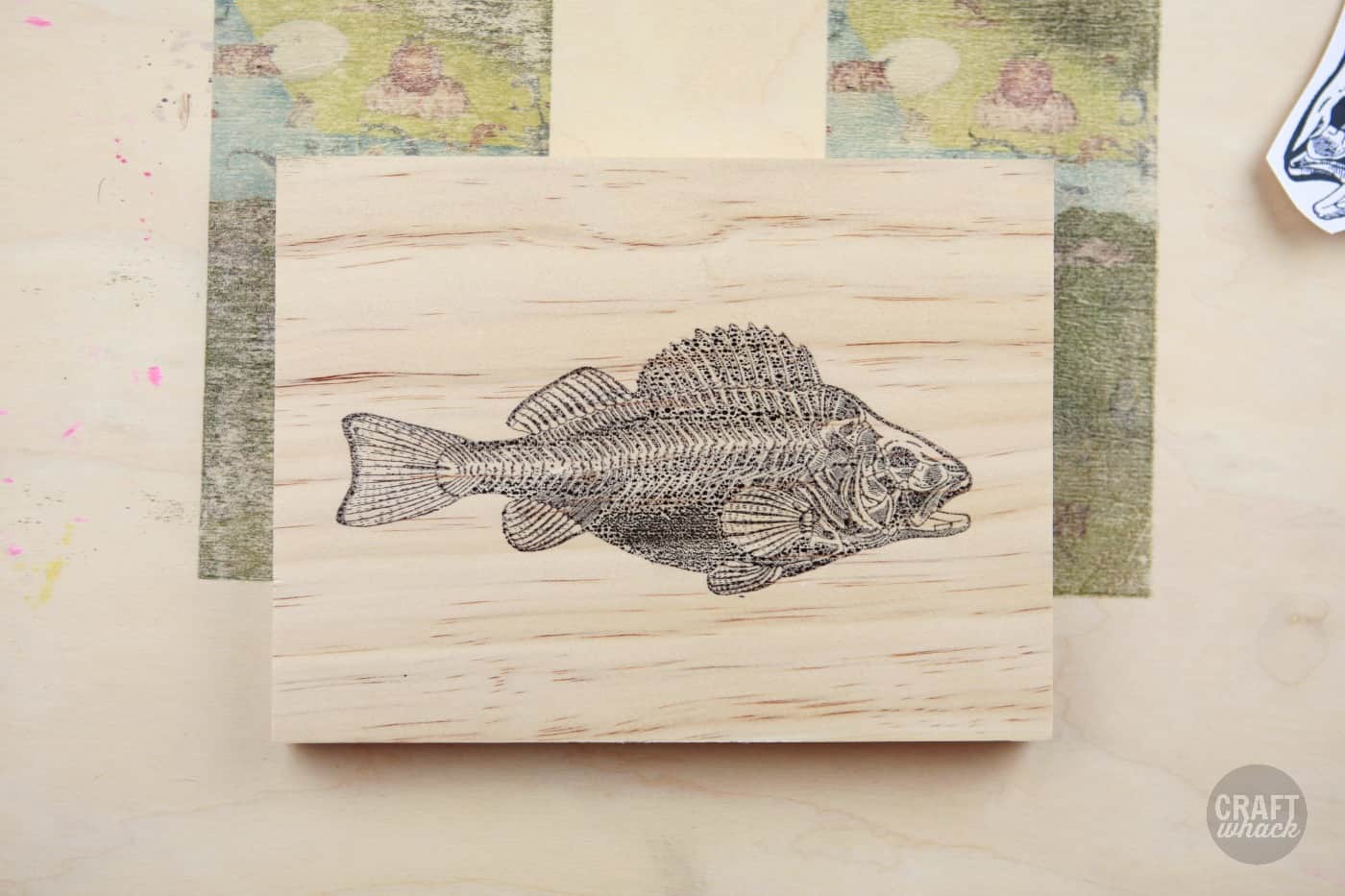
An alternative to wax and freezer paper, the waxy backing to sticker or label printer papers work for this process. I guess I wouldn’t buy these papers just to use for image transfer, but if you have some around, you may want to go this route.
Spray a clear finish coating over the top of these prints to protect them and to give the wood and print more visual depth.
Wax Paper and Freezer Paper Pros and Cons
Pros: You can use inkjet prints, you probably already have wax or freezer paper at home, they’re fast and unmessy.
Cons: Sometimes the paper gets jammed in the printer, the print can look a little ‘rustic’ if you’re expecting a pristine print.
Inkjet Transfer Using T-Shirt Transfer Paper
You can transfer an inkjet print to wood using t-shirt transfer paper, and it works beautifully!
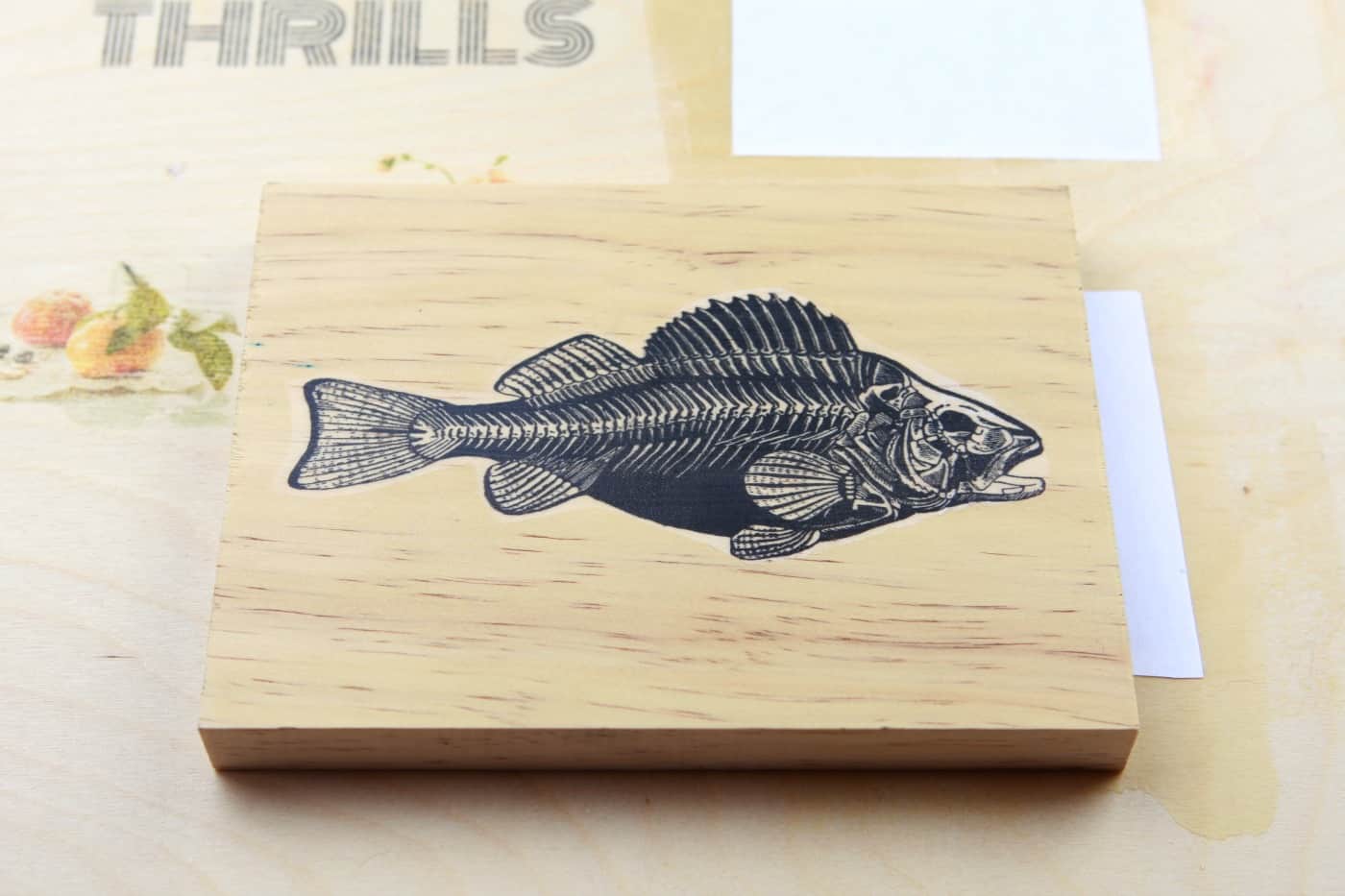
Supplies:
- Inkjet printer
- T-shirt transfer paper – I used Up & Up t-shirt transfer paper from Target, but I’m pretty sure they’re all similar enough to get the same results…
- Iron
- Thin cloth or pillowcase
- Clean, smooth, unfinished wood surface
This method is easier than the 2 previous techniques because you just need to print your image onto the paper and iron it onto your wood surface. The results are pretty awesome with this; you get a nice clean, saturated print.
Again, if you are going for a more rustic look, you may want to stick with waxy papers.
Technique:
- Print your (mirror-reversed) image onto the t-shirt transfer paper in your inkjet printer.
- Let the print sit for about 5 minutes.
- Place it face down onto your wood surface and cover the back with a thin cloth or pillowcase.
- With your iron set to the highest cotton setting, and NO STEAM, press down firmly onto a section at a time of your print. I kept the iron down on each section for about 15 seconds. Maybe move it if you start to smell it burning. 🙂
- Let the whole thing cool for a few minutes.
- Peek under the paper in areas to see if the image has transferred, and make sure you cover the whole image with the iron – you can potentially rip the image if it isn’t evenly ironed.
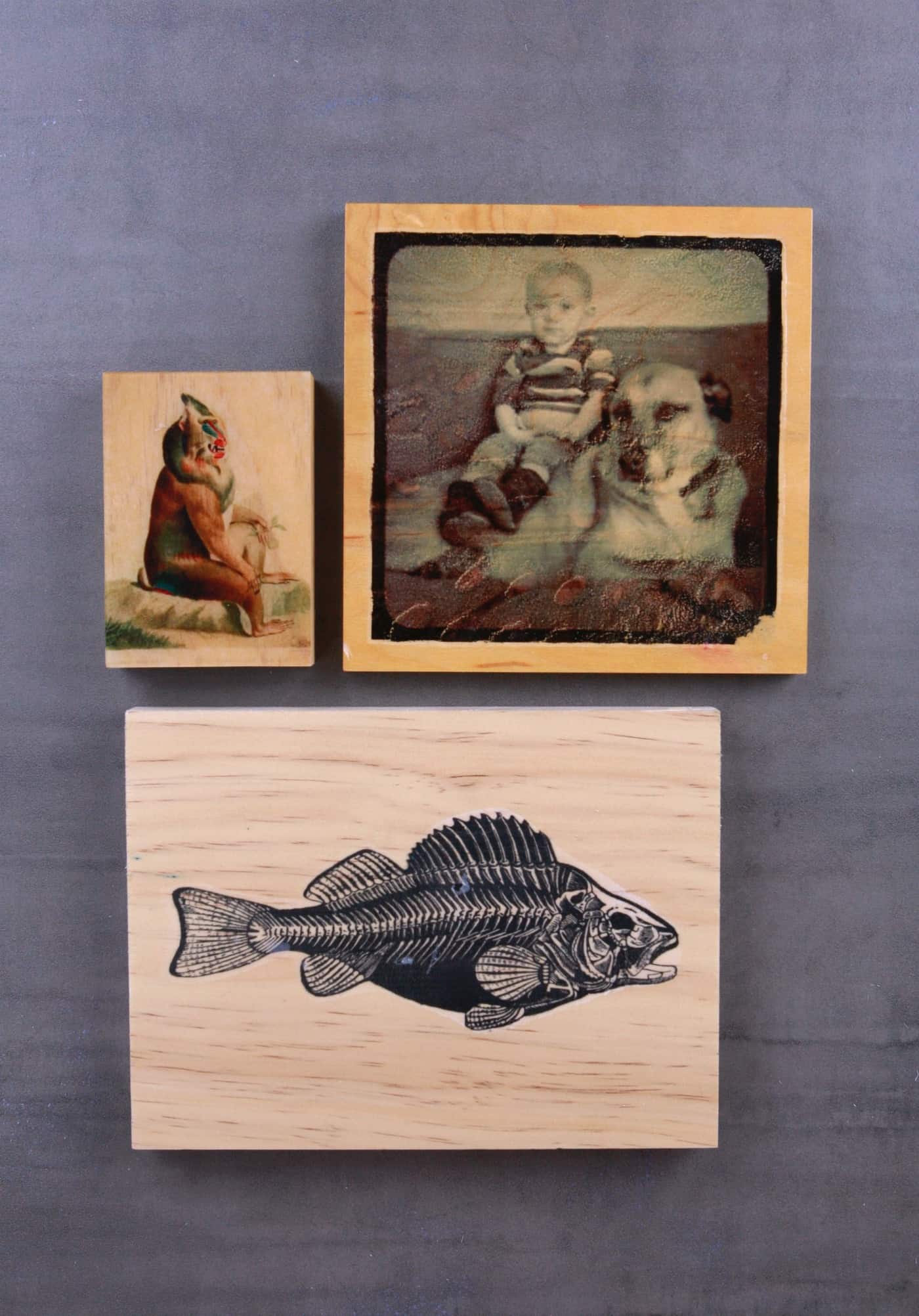
The monkey-type creature was made by my husband a few years ago, and he used a 2-part epoxy over the surface to get that glossy finish. He then cut the edges of the wood off. We keep him in a little nook in our kitchen and he chats with me as I make dinner.
The pic of little Beckett and our old dog Farmer was tweaked in Photoshop to look oldy-fashionedy, and then the same epoxy on top.
My daughter and I used this technique for a self-portrait art project a while back, and I can’t remember what I did to make it look that weathered. I think we ironed right onto the back of the transfer paper, and for a long time, so the paper sort of buckled up in places.
Inkjet T-Shirt Paper Transfer Pros and Cons
Pros: Prints are beautiful, crisp, and saturated, the process is easy and mess-free.
Cons: Sometimes part of the print doesn’t want to iron down completely; you may need to repeat your ironing process a few times if a section doesn’t transfer.
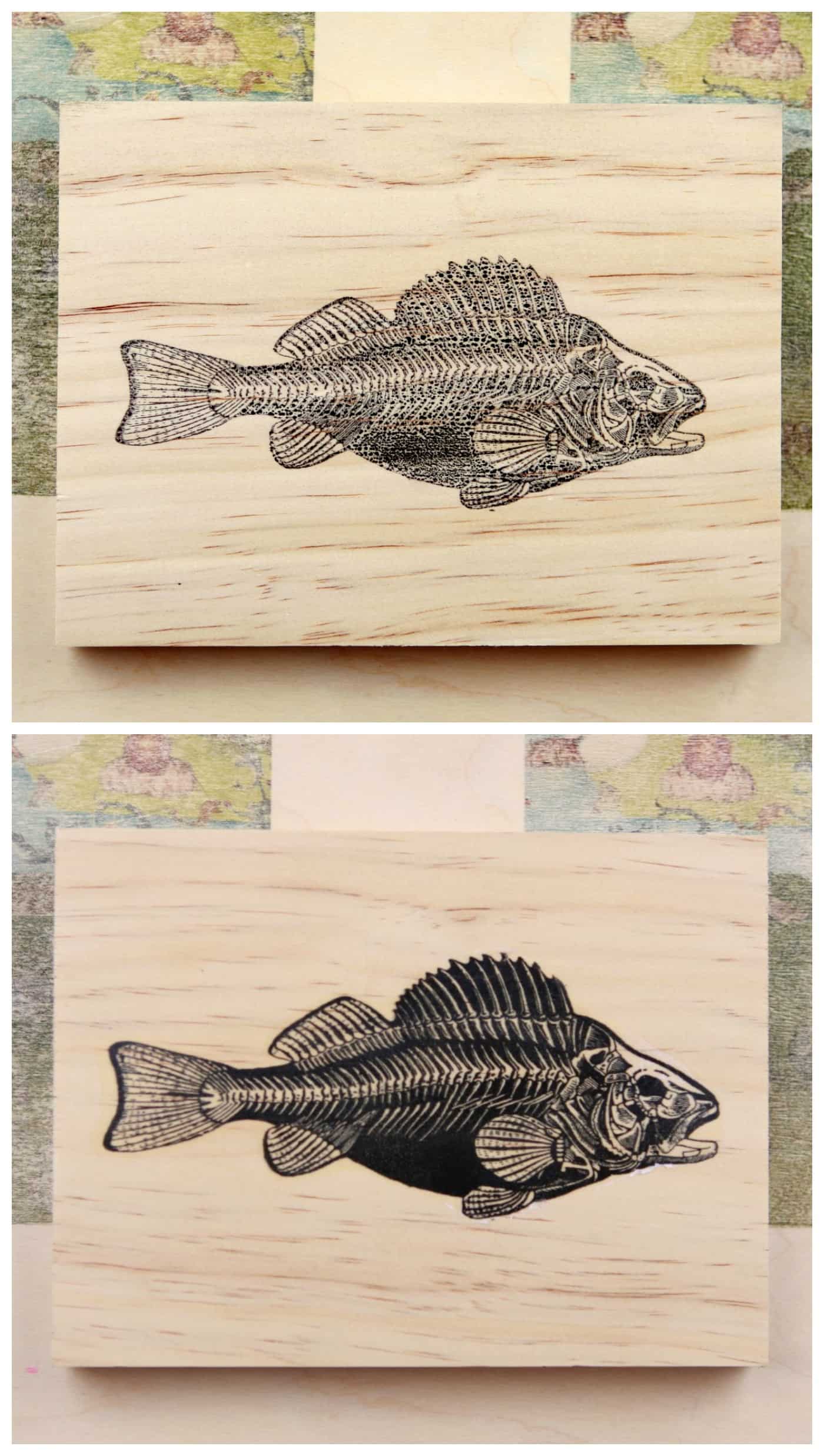
Using Mod Podge or Acrylic Gel Medium For An Image Transfer
I learned this technique in college using acrylic gel medium. Well, actually 2 techniques to transfer images using gel medium, so I’ll show you both!

One is more along the lines of the print transfers I’ve outlined above, and the other will result in the image transferred onto the dried gel medium alone, so you can use that layer of plasticky stuff to collage onto your wood, etc.
Supplies
- Acrylic gel medium or Mod Podge
- Laser print on regular printer paper (not photo paper!) Want a larger print? Bring your USB to FedEx and ask for an engineering print.
- Brush
- Eraser
To get the best print using Mod Podge or gel medium, brush a layer of the medium onto your entire wood surface, as evenly as possible. This should be thick enough to not leave any areas of the wood bare, but don’t just glop a thick layer on.
Note: I’ve only done this process using gel medium, but I know Mod Podge can work the same way. I have read to paint a layer of Mod Podge onto the surface of your image as well as the surface of your wood before pressing them together, so you may want to try this.
Place the print face down onto the wood, press it out with the scraper or credit card, and let it dry overnight. Don’t press down too hard or the gel will ooze out all over the place; I usually just use my fingers to smooth it onto the top of the layer of gel.
Wet the back with water and rub the paper off with your fingers, an eraser, or a combination of the two. I usually start by putting water on the paper with my fingers, rub it in a bit, use the eraser for the bulk of the removal, then use my fingers to remove the very last bits of paper pulp.

You can now go back over the image with another layer of Mod Podge or medium, or you can go in with acrylic paint or paint-tinted medium first. Ooh! Arty!

I did an experiment with 4 different types of gel medium to see which worked the best, and the results were shocking! Not really, but there is a clear winner.
You May Also Like: Best Sublimation Printer
The 4 gel mediums I used were:

My favorite was the fluid matte Liquitex (4). It gave the richest print, the paper came off the easiest, it’s a matte finish, and the ink didn’t scratch when I was removing the paper.
You can see the two top prints scratched away quite a bit when I was removing the paper. The bottom left one did a little bit, but it looks a little milky. The bottom right stayed on there pretty well, and looks more saturated.
This is a Nat Geo page pressed down onto a layer of gel medium. This works pretty well, too, maybe a little more stubborn to get all the paper off.

Gel Medium and Mod Podge Transfer Pros and Cons
Pros: Your wood can be a little less perfectly smooth since the image is being transferred to the gel sitting on top of the wood, it’s easy to get a great print.
Cons: You need to use laser prints or photocopies. Inkjet prints won’t work at all or will smear.
Gel Medium Print Transfer Technique #2
This is probably not what you were looking for if you searched for wood transfer print techniques, but I need to include it because it’s magical.
Supplies
- National Geographic magazine pages (I’ve heard Vogue works, too. Something about the ink quality with these mags)
- Acrylic gel medium – I used Golden Soft Gloss Gel
- Brush
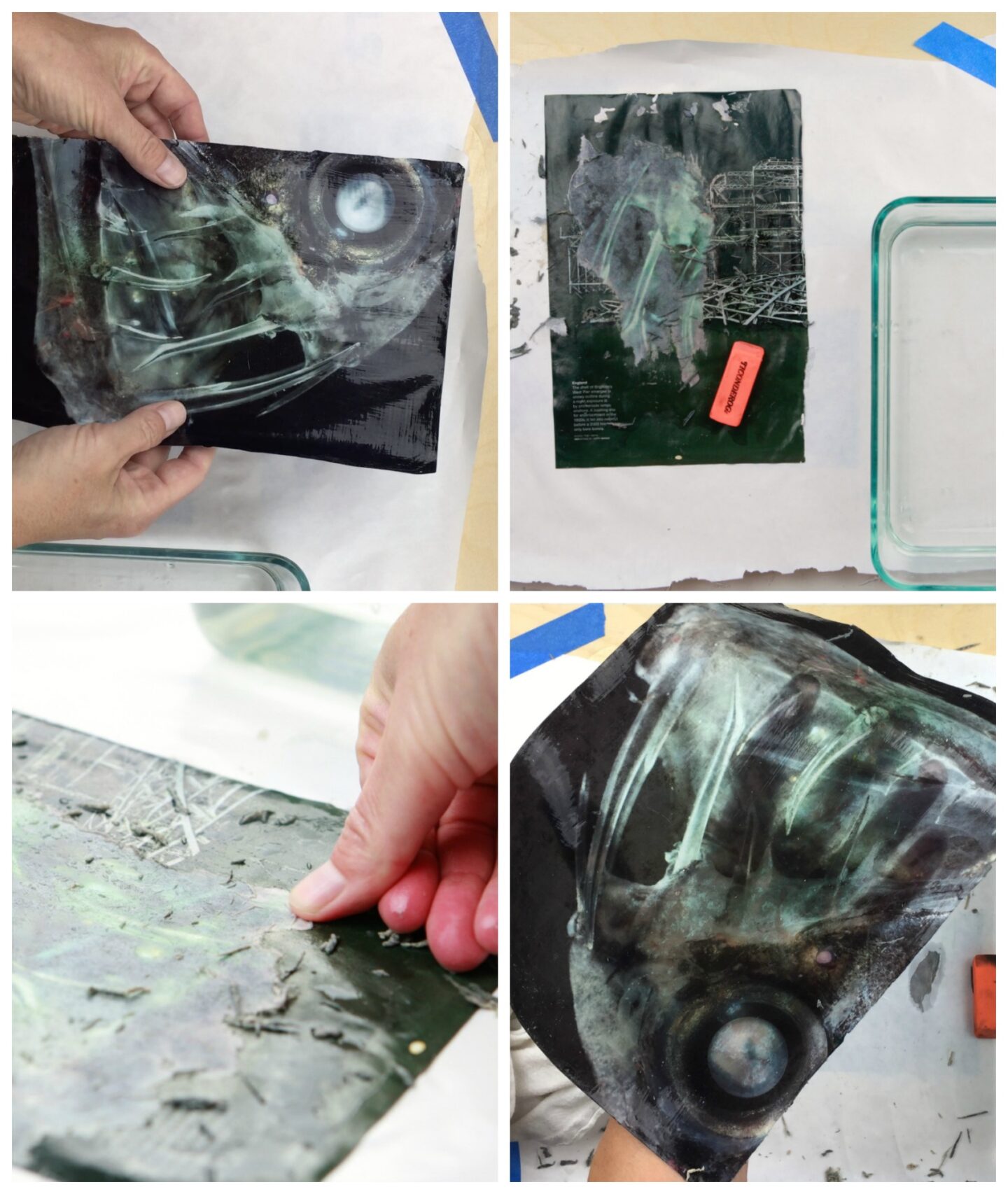
Technique
- Brush at least 10 layers of gel medium onto your magazine page, letting it dry completely in between layers.
- Remove paper using the water/eraser/fingers technique.
- You will be left with a thick layer of gel medium with the image transferred on, and you can use it as is or cut it up and collage with it.
Tip: You can choose images from the magazine other than nightmarish deep-sea creatures; I just happen to love that little fella.
Blender Marker Print Transfer Onto Wood
I had seen somewhere that you can transfer laser prints onto wood with a blender marker, so I grabbed my Prismacolor blender and got to work.
The joke was on me, cause nothing transferred. So I took to Google and learned that you need a blender pen with Xylene in it, and this is the only one I could find that contained that substance.
Supplies
- Laser print, preferably black and white
- This blender marker, or another with Xylene
- Smooth, unfinished wood surface
To transfer an image onto wood using a blender marker, you must, first of all, use a laser print, then you basically just color over the face-down image onto the wood.
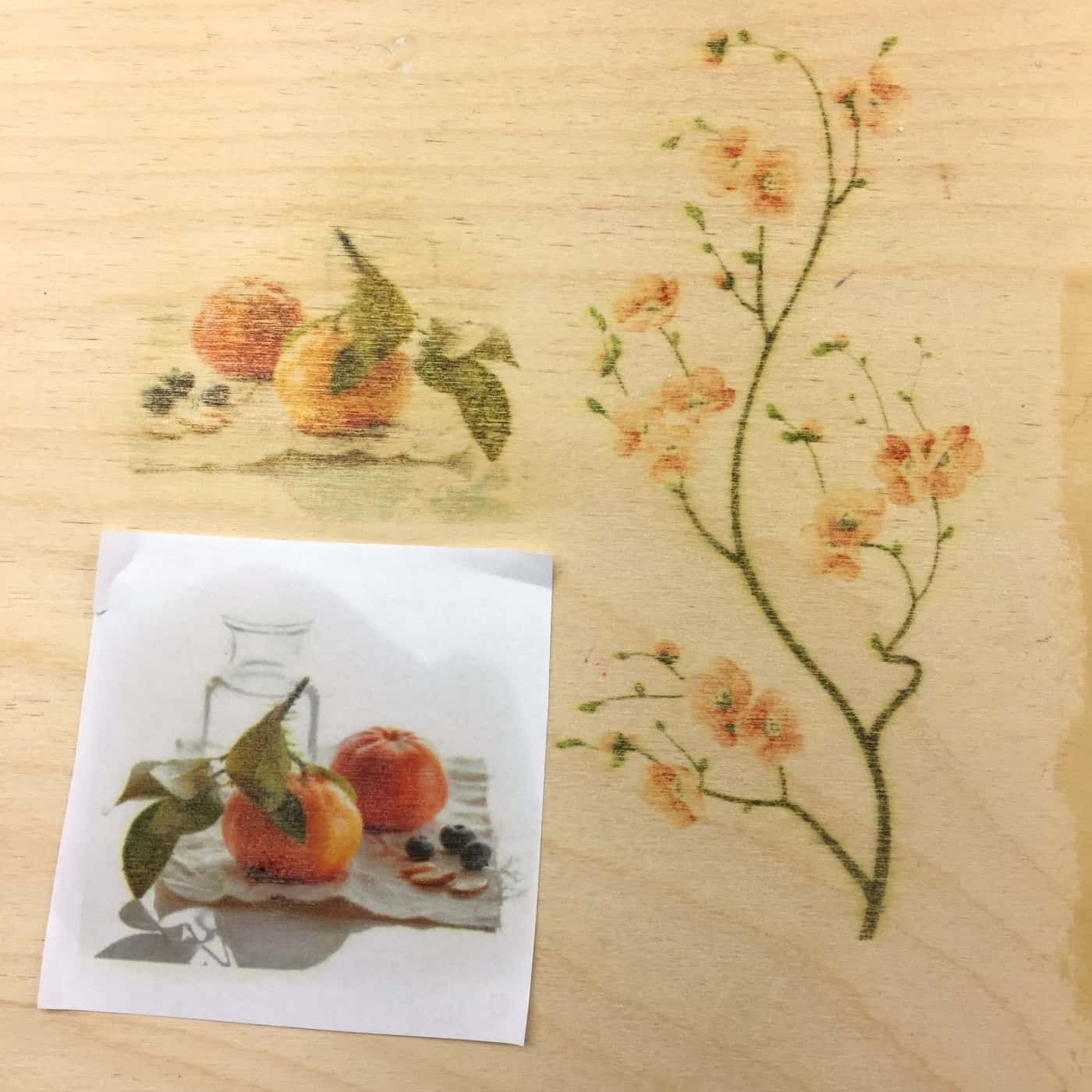
It helps to make some practice transfers, because if you’re overzealous with the amount of marker you use, the ink can smear. I used my plastic scraper to give my images a final little burnishing before I peeled them up, also.
The color ones didn’t look as good as the black and white ones, so I’ll stick to B&W from now on with this technique. Can’t wait to try this on paper!
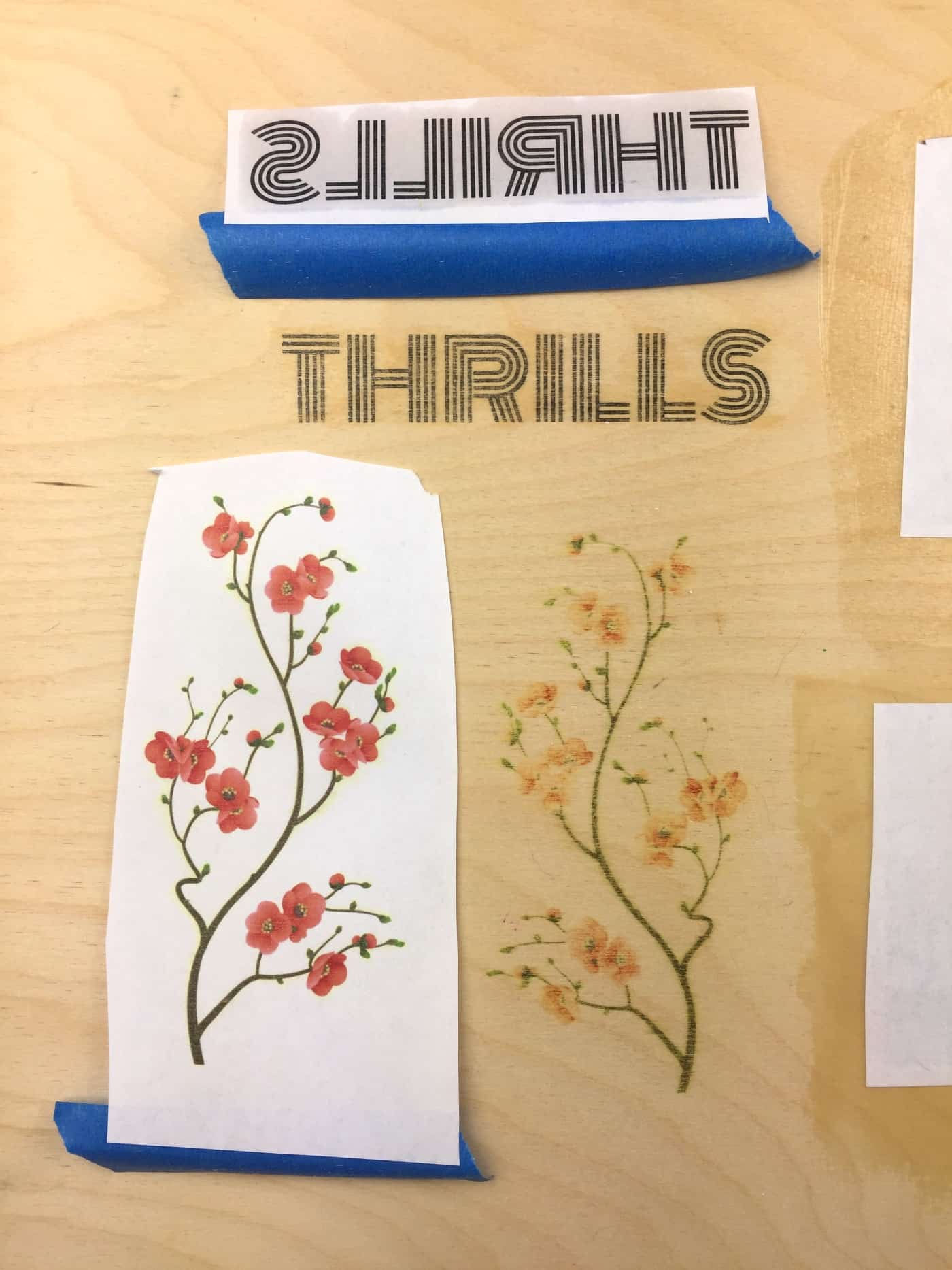
Pros and Cons of Blender Marker Transfer
Pros: It’s fast and easy to do.
Cons: The Xylene in the marker smells hella atrocious and you really need to do this in a well-ventilated area. Also, the ink can pool if you use too much marker.
Acetone Print Transfer Onto Wood
It turns out acetone is good for something besides removing your shmancy gel nail polish. You can transfer laser prints onto wood with it!
Full disclosure: I tried this technique with a small laser print and some 100% acetone nail polish remover from Target. I tried it twice, but I couldn’t get it to work. Not sure what my problem was, but I gave up on it since acetone is freaking STINKY.
I suggest if you try this technique to do it next to an open window, outdoors, or while wearing a mask so you aren’t breathing all that stank in.
I’ll give this a try another time because I must figure out what I did wrong.
In the meantime, here’s a video to watch if you want to see someone else successfully transferring a print onto wood using acetone.
Citrasolv Print Transfer Onto Wood
You may still have some Citrasolv concentrate left over after making National Geographic melted ink pages. You did make some, didn’t you?
To transfer your print (it must be a laser print or copy from a photocopy machine.) onto wood with Citrasolv concentrate:
- Dampen a cotton ball or paper towel with some of the Citrasolv.
- Press it onto the back of your print that you have lying on the wood.
- Rub it in gently with your finger (Citrasolv is all-natural)
- Use your card or brayer to rub it onto the wood surface, then remove the print.
- The Citrasolv will evaporate and leave you a lovely image transfer on your wood.
- Use Citrasolv concentrate, not Citrasolv cleaner, or your art endeavors won’t work.
This is a cute project by Ashley Hackshaw where she Citrasolv transferred a print onto a bent wood crown for her daughter.
Citrasolv Transfer Pros and Cons
Pros: Citrasolv is a natural product, you can use whatever is left in your bottle for more art projects or for actually cleaning your home!
Cons: Citrasolv is a little messy, and you probably need to buy it online, as it’s hard to find in stores.
Print Transfer Onto Painted Wood
You can transfer your images onto painted wood using the wax and freezer paper methods, but make sure the paint finish is super smooth. Rough finishes only accept the ink onto the raised areas, so you’ll end up getting a terrible transfer if you leave brushstrokes or rough areas on your painted surface.
A better transfer method for painted wood is to transfer a laser print right into the wet paint. I used gesso for this cherry print, but you can lay down a layer of acrylic paint and get the same look.
Try to make sure your paint surface is smooth for the best results. I experimented with dotting 3 different paint colors on the wood, and the transfers came out uneven, despite burnishing them in with a credit card.
In fact, you could probably get some cooler effects with different images- this transfer looks a little like I just glued a printout image down on the gesso.
I just had an idea: you could probably transfer an image onto painted wood by using gel medium over the paint and transferring the image into the gel.
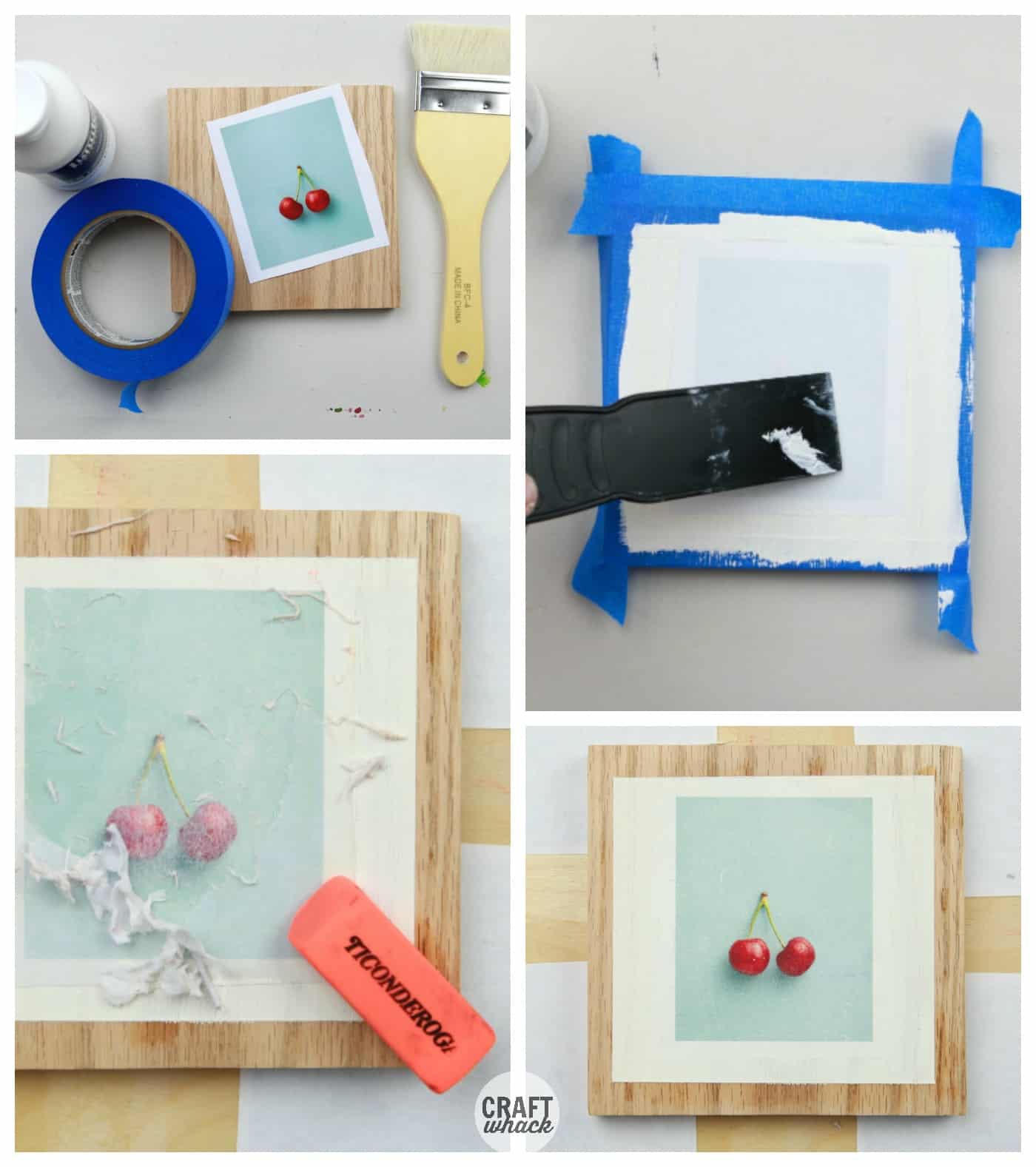
Mixing Print Transfer Techniques
Here’s where I got absolutely nuts and combined 2 wood transfer techniques. My first transfer was using the iron-on paper with this lovely colorful raindrop pattern.
After that had cooled, I used the Liquitex Matte Medium to transfer this skull, and yep, I totally forgot to mirror the image before getting it printed, but I used it anyway.
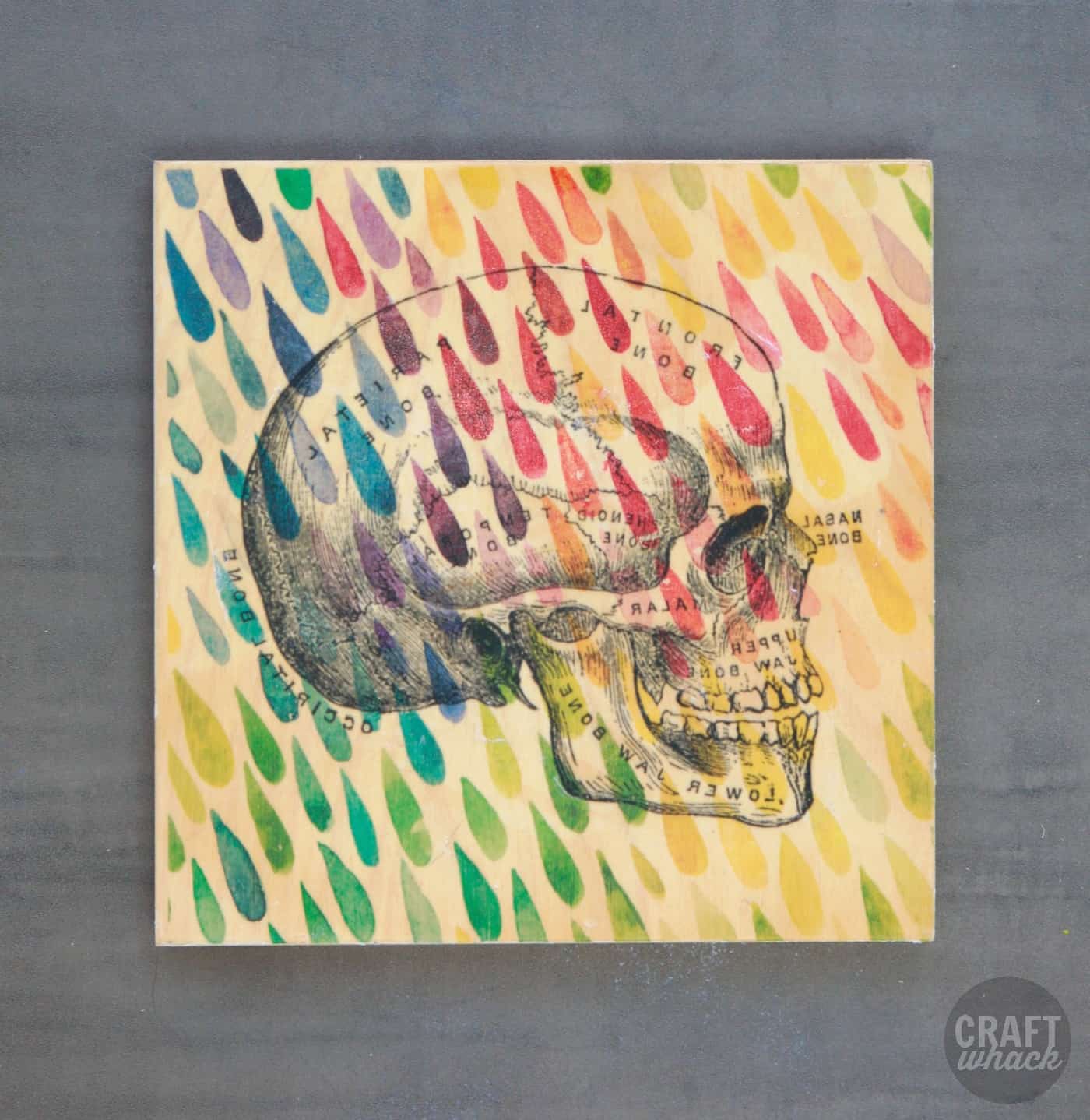
I have some weird urge to end this blog post like my daughter used to end her paragraphs in elementary school.
In conclusion, I hope you liked my blog post and learned a lot about the many ways to transfer images onto a wood surface.
Seriously, though. If you are inspired to try something you see here, will you either post an image here in the comments or on Instagram and tag me @Craftwhack? I want to see. I do.
You may have noticed that many of these techniques are totally kid-friendly, so if you and your kids totally get bitten by the printmaking bug, I also have a big list of printmaking ideas to do with kids over here. Oh yeah, have you tried packing tape image transfer yet? You’ll love it!
Pin it:
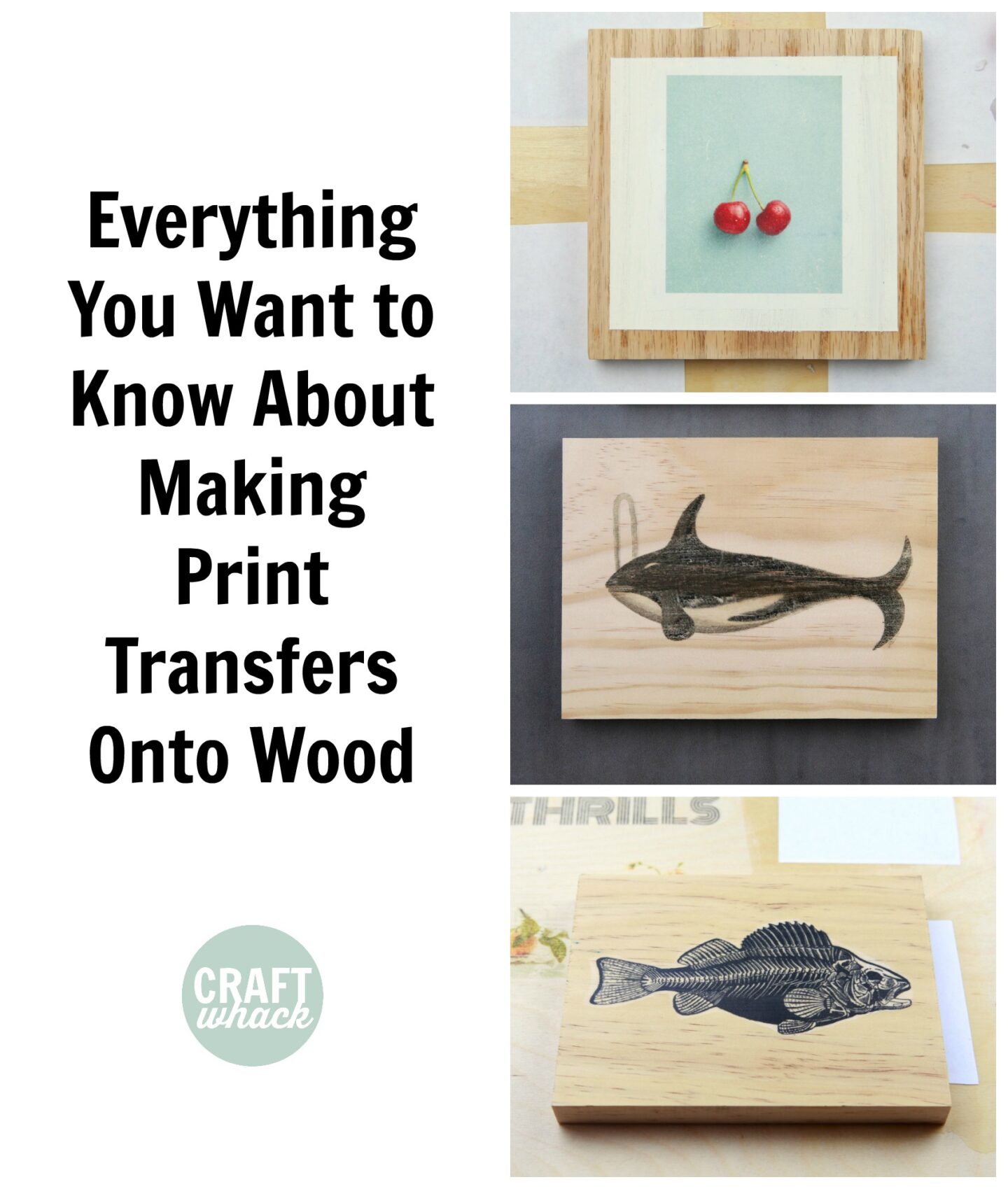
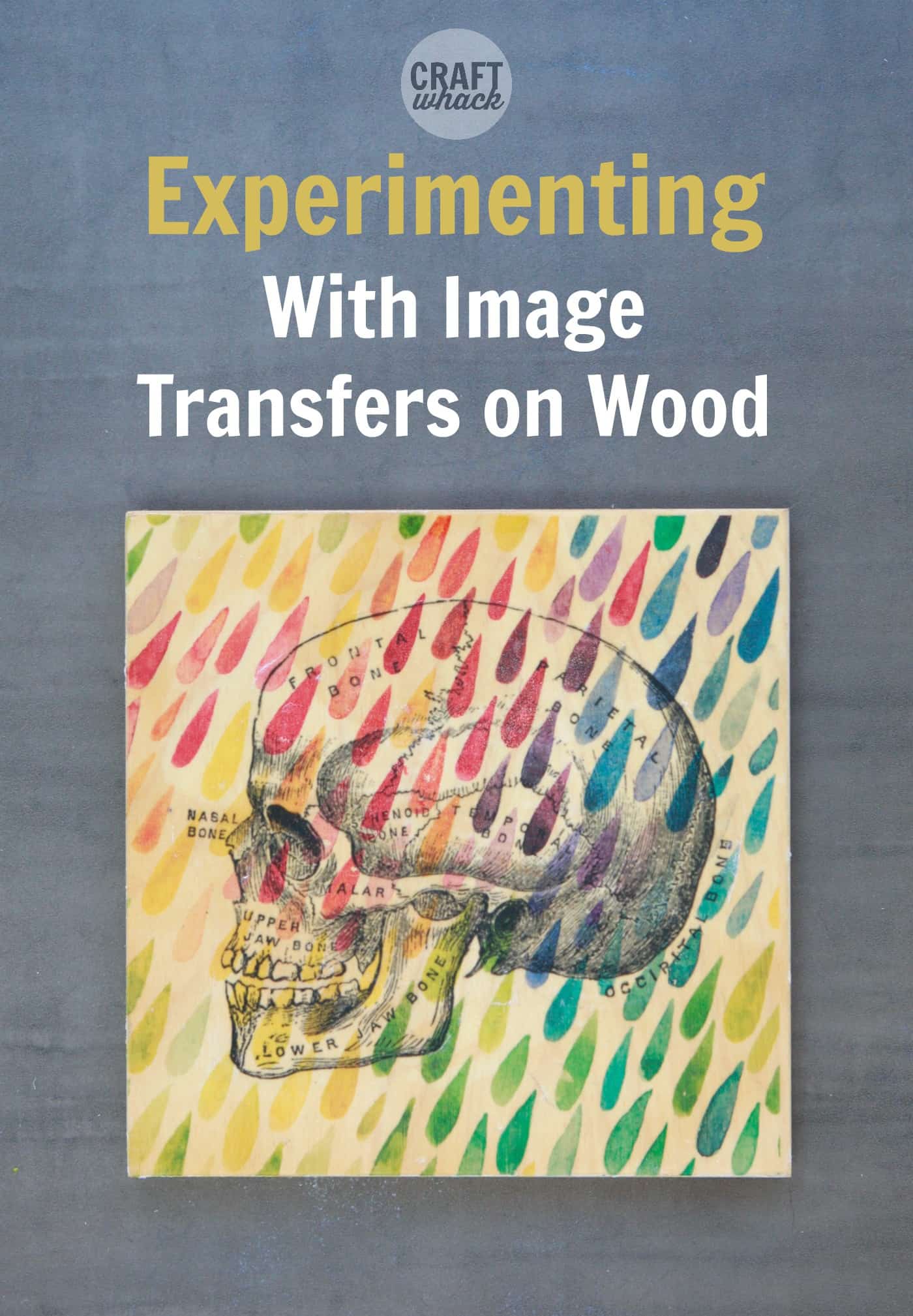
You May Also Like: Best Printer for Heat Transfers
Comments
0 comments

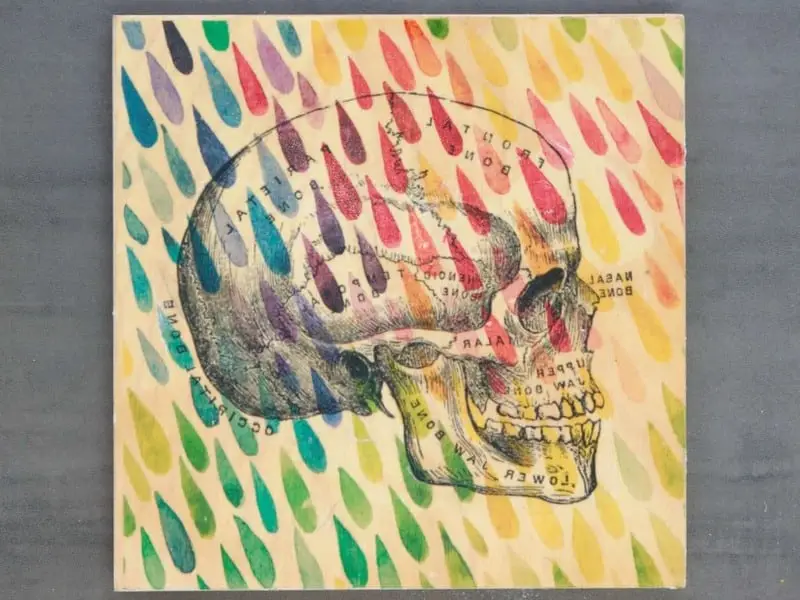
WHAT?!? I did not know about transparency paper transfer. Now I need to get my hands on some and add that to the experiments. Did it work well for you?
Thank you so much for this! My brother just recently got married and for a Christmas present I wanted to do a wood transfer with one of the wedding photos. I’ve done a few of these techniques over the years but I’ve never seen them compared like this so it’s helping me narrow it down to find the best technique for the effect I want.
You mentioned ” mirror reversed ” could you explain that part I dont understand, do I some how reverse the image prior to printing?
Can I use photos printed on photo paper to transfer on wood using poly acrylic?
This post is EXACTLY what I’ve been hoping to find! Thanks so much for doing all the experimenting for me/us! I’m so so so excited to get started :):).
I just wanted to mention, that I think perhaps the reason your “acetone” experiment didn’t work, is that you used nail polish containing acetone instead of pure acetone. I buy the pure stuff to mix with acrylic paints for customizing leather/pleather items. It helps the paint “eat” into the leather, which causes it to sort of “bond” with the item’s surface, instead of just sitting on the surface. Pure acetone is super cost friendly, and it’s sold at any store with a hardware section. Happy crafting – I can’t wait to read more from you!
Wow this is super helpful, thank you for keeping it simple and to the point!!!
I am really impressed with your writing skills and also with the layout on your weblog.
Is this a paid theme or did you customize it yourself?
Anyway keep up the nice quality writing, it’s rare to see a great blog like this one
these days.
Hey there, You’ve done an incredible job. I will certainly digg it and personally recommend
to my friends. I am sure they will be benefited from this website.
Excellent post! We will be linking to this great post on our site.
Keep up the great writing.
You should be a part of a contest for one of the most useful blogs on the web.
I most certainly will recommend this web site!
Wow, that’s what I was searching for, what a stuff! existing here
at this webpage, thanks admin of this web site.
Hello, its good paragraph about media print, we all
be aware of media is a impressive source of data.